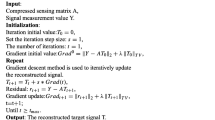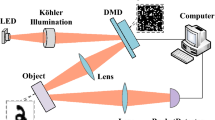Abstract
Compressed ghost imaging method can effectively reduce the number of measurements required for ghost imaging reconstruction. The non-negative characteristics of measurement matrix in compressed ghost imaging method is inconsistent with the requirements of the measurement matrix in traditional compressed sensing theory, leading to low quality reconstruction. Aiming at the point, this paper proposes a singular value decomposition compressed ghost imaging method to improve the reconstruction quality of ghost imaging. First, the singular value decomposition is performed on the measurement matrix, and then the optimized measurement matrix and measurements are obtained, finally the reconstruction of the image is completed by the reconstruction algorithm. Numerical simulation experiments verify the superiority of our proposed singular value decomposition compressed ghost imaging method.









Similar content being viewed by others
Change history
28 March 2022
A Correction to this paper has been published: https://doi.org/10.1007/s00340-022-07804-z
References
M. D’Angelo, A. Valencia, M.H. Rubin et al., Resolution of quantum and classical ghost imaging. Phys. Rev. A 72(1), 013810 (2005)
B.I. Erkmen, J.H. Shapiro, Ghost imaging: from quantum to classical to computational. Adv. Opt. Photon. 2(4), 405–450 (2010)
J.H. Shapiro, Computational ghost imaging. Phys. Rev. A 78(6), 061802 (2008)
T.B. Pittman, Y.H. Shih, D.V. Strekalov et al., Optical imaging by means of two-photon quantum entanglement. Phys. Rev. A 52(5), R3429 (1995)
D.V. Strekalov, A.V. Sergienko, D.N. Klyshko et al., Observation of two-photon “ghost” interference and diffraction. Phys. Rev. Lett. 74(18), 3600 (1995)
R.S. Bennink, S.J. Bentley, R.W. Boyd, “Two-photon” coincidence imaging with a classical source. Phys. Rev. Lett. 89(11), 113601 (2002)
D. Shi, C. Fan, P. Zhang et al., Adaptive optical ghost imaging through atmospheric turbulence. Opt. Express 20(27), 27992–27998 (2012)
W.K. Yu, S. Li, X.R. Yao et al., Protocol based on compressed sensing for high-speed authentication and cryptographic key distribution over a multiparty optical network. Appl. Opt. 52(33), 7882–7888 (2013)
C. Hao, W. Gong, M. Chen et al., Ghost imaging lidar via sparsity constraints. Appl. Phys. Lett. 101(14), 141123 (2012)
X.F. Liu, X.R. Yao, X.H. Chen et al., Thermal light optical coherence tomography for transmissive objects. JOSA A 29(9), 1922–1926 (2012)
S. Jiao, J. Feng, Y. Gao, T. Lei, Z. Xie, X. Yuan, Optical machine learning with incoherent light and a single-pixel detector. Opt. Lett. 44(21), 5186–5189 (2019)
Y. Zuo, B. Li, Y. Zhao, Y. Jiang, Y.-C. Chen, P. Chen, G.-B. Jo, J. Liu, S. Du, All-optical neural network with nonlinear activation functions. Optica 6(9), 1132–1137 (2019)
W.K. Yu, M.F. Li, X.R. Yao et al., Adaptive compressive ghost imaging based on wavelet trees and sparse representation. Opt. Express 22(6), 7133–7144 (2014)
F. Ferri, D. Magatti, L.A. Lugiato et al., Differential ghost imaging. Phys. Rev. Lett. 104(25), 253603 (2010)
M.F. Li, Y.R. Zhang, K.H. Luo et al., Time-correspondence differential ghost imaging. Phys. Rev. A 87(3), 033813 (2013)
B. Sun, S.S. Welsh, M.P. Edgar et al., Normalized ghost imaging. Opt. Express 20(15), 16892–16901 (2012)
O. Katz, Y. Bromberg, Y. Silberberg, Compressive ghost imaging. Appl. Phys. Lett. 95(13), 131110 (2009)
P. Zerom, K.W.C. Chan, J.C. Howell et al., Entangled-photon compressive ghost imaging. Phys. Rev. A 84(6), 061804 (2011)
V. Katkovnik, J. Astola, Compressive sensing computational ghost imaging. JOSA A 29(8), 1556–1567 (2012)
M. Aβmann, M. Bayer, Compressive adaptive computational ghost imaging. Sci. Rep. 3, 1545 (2013)
C. Zhang, S. Guo, J. Cao et al., Object reconstitution using pseudo-inverse for ghost imaging. Opt. Express 22(24), 30063–30073 (2014)
W. Gong, High-resolution pseudo-inverse ghost imaging. Photon. Res. 3(5), 234–237 (2015)
X. Zhang, X. Meng, X. Yang et al., Singular value decomposition ghost imaging. Opt. Express 26(10), 12948–12958 (2018)
X. Shi, X. Huang, S. Nan et al., Image quality enhancement in low-light-level ghost imaging using modified compressive sensing method. Laser Phys. Lett. 15(4), 045204 (2018)
Y.C. Pati, R. Rezaiifar, P.S. Krishnaprasad, Orthogonal matching pursuit: recursive function approximation with applications to wavelet decomposition. In: Proceedings of 27th Asilomar conference on signals, systems and computers. IEEE, pp. 40–44 1993
E.C. Marques, N. Maciel, L. Naviner et al., A review of sparse recovery algorithms. IEEE Access 7, 1300–1322 (2018)
E.J. Candès, The restricted isometry property and its implications for compressed sensing. Comptes Rendus Math. 346(9–10), 589–592 (2008)
E.J. Candès, Y. Plan, A probabilistic and RIPless theory of compressed sensing. IEEE Trans. Inf. Theory 57(11), 7235–7254 (2011)
E. Candès, J. Romberg, Sparsity and incoherence in compressive sampling. Inverse Probl. 23(3), 969 (2007)
Acknowledgements
This project was supported by the Natural Science Foundation of Anhui Province (No. 2008085MF209), the Major Natural Science Foundation of Higher Education Institutions of Anhui Province (Nos. KJ2019ZD04, KJ2020ZD02), and Open Research Fund of Advanced Laser Technology Laboratory of Anhui Province (AHL2020KF05).
Author information
Authors and Affiliations
Corresponding author
Additional information
Publisher's Note
Springer Nature remains neutral with regard to jurisdictional claims in published maps and institutional affiliations.
Rights and permissions
About this article
Cite this article
Zhang, C., Tang, J., Zhou, J. et al. Singular value decomposition compressed ghost imaging. Appl. Phys. B 128, 47 (2022). https://doi.org/10.1007/s00340-022-07768-0
Received:
Accepted:
Published:
DOI: https://doi.org/10.1007/s00340-022-07768-0




